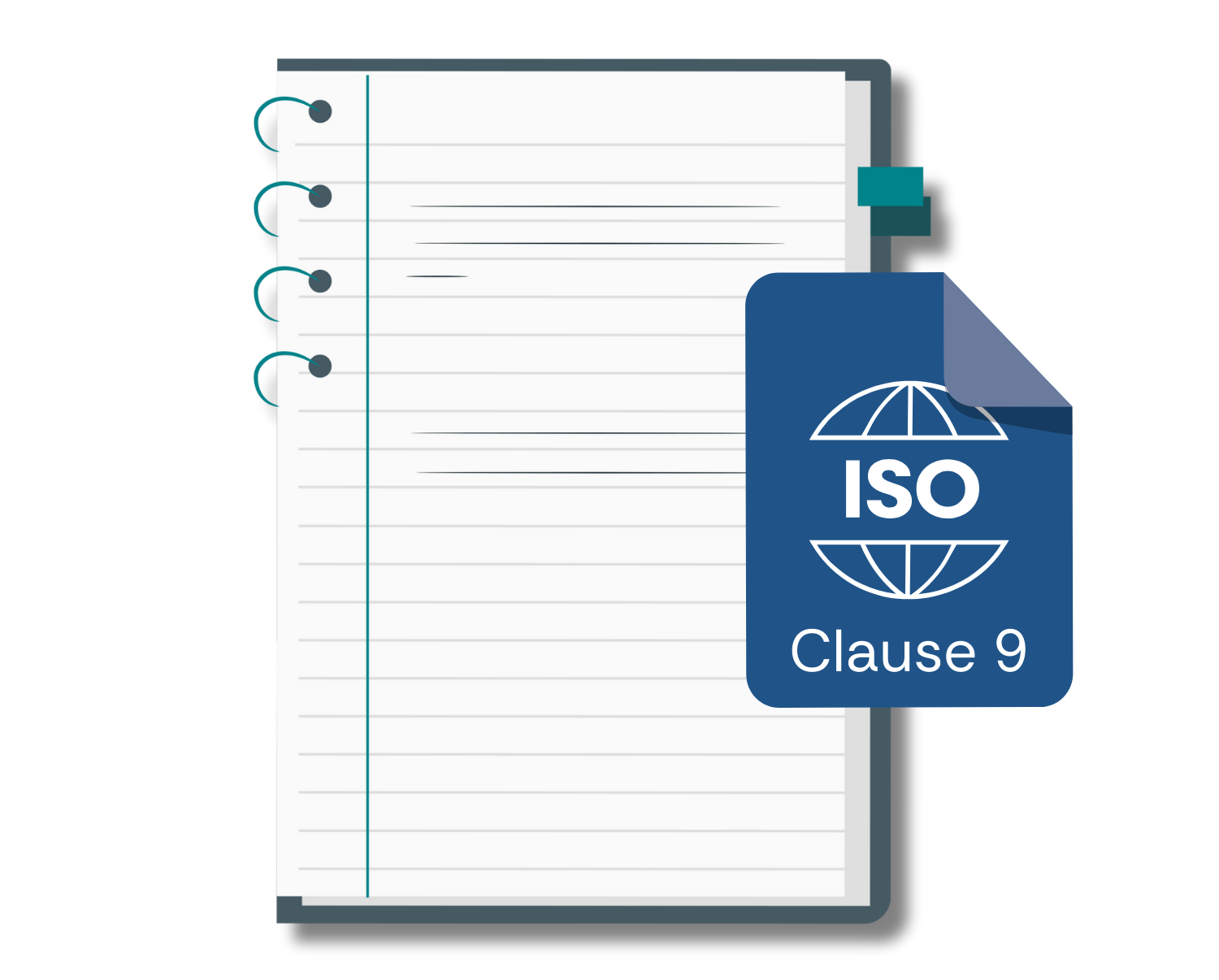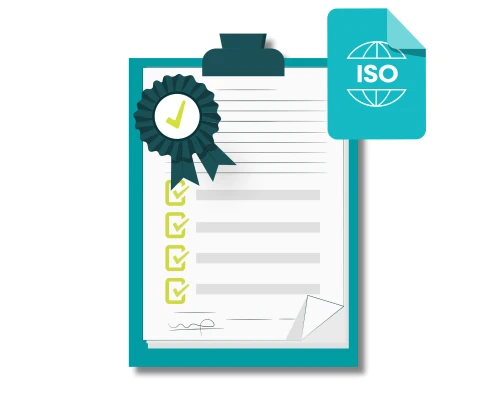When getting to grips with ISO (International Organisation for Standardisation) standards for the first time, you will notice that they are structured in clauses, a bit like a contract. This structure is common across all of the management system standards that ISO publishes, such as ISO 9001, ISO 22301 and ISO/IEC 27001, and is known as the “Annex SL” format or, more helpfully, the “High Level Structure”.
So, what we’re about to say applies to all of these standards. Note however that the Annex SL wording has evolved over time, so the exact format and wording of each standard depends not only on its subject, but also on when it was last revised.
Welcome to Clause 9 – Performance Evaluation
Clause 9 plays a pivotal role in ISO management systems, as it centres on performance evaluation – the cornerstone of continual improvement. The clause includes the following subclauses:
9.1 Monitoring, measurement, analysis and evaluation
9.2 Internal Audit
9.3 Management Review
Before we look at each of these in a little more detail, it’s worth familiarising ourselves with key concepts such as monitoring, measurement, compliance, internal audit, and management review.
Key Concepts
It is important to note that the specific content and structure of clause 9 may vary slightly depending on the individual ISO management system standard. However, there are a number of key concepts that are commonly found within clause 9.
These concepts include:
Monitoring, Measurement, Analysis, and Evaluation (MMAE): Clause 9 often emphasises the need for organisations to establish processes for systematically monitoring, measuring, analysing, and evaluating their performance. This includes performance related to the management system and its objectives.
Data and Information: Organisations are expected to collect relevant data and information to support their performance evaluation processes. This data may come from various sources, including internal and external factors.
Performance Indicators and Metrics: ISO standards typically require organisations to define key performance indicators (KPIs) and metrics to assess the effectiveness and efficiency of their processes and the achievement of objectives.
Internal Audit: Clause 9 includes requirements for conducting internal audits. These are essential for assessing compliance with the management system’s requirements and identifying opportunities for improvement.
Management Review: the standards include a requirement for top management to periodically review the organisation’s performance and the effectiveness of the management system. These reviews help in making informed decisions and driving continuous improvement.
Since the specific requirements and details of clause 9 can vary from one ISO management system standard to another, organisations implementing a specific ISO standard should refer to that standard’s specific requirements and guidelines for this clause.
So let’s now look at each of the subclauses.
Clause 9.1 Monitoring, measurement, analysis and evaluation
This subclause varies a little across the standards, for example in ISO9001 there is an extra subclause that deals with customer satisfaction, ISO14001 has a subclause that deals with evaluation of compliance, and in ISO27001 and ISO22301 there are no subclauses at all.
Monitoring and measurement are the bedrock of performance evaluation. They involve systematic data collection and analysis to gauge the performance of processes, products, or services.
Monitoring involves the systematic and ongoing collection of data about your processes, products, or services. It’s like having a real-time view of what’s happening. On the other hand, measurement involves quantifying this data to make it meaningful, for instance measuring customer satisfaction using a numerical scale. Monitoring and measurement together ensure that you have accurate information to make informed decisions and identify areas for improvement.
Clause 9.1 generally requires the organisation to determine:
What needs to be monitored and measured
The methods for monitoring, measurement, analysis and evaluation needed to ensure valid results
When the monitoring and measuring is performed
Who does the monitoring and measuring
When the results are analysed and evaluated
Who does the analysing and evaluating
But some of the standards go into more detail in specific areas. ISO9001 requires you to also look at:
Conformity of products and services
Degree of customer satisfaction
Performance and effectiveness of the QMS
If planning has been implemented effectively
Effectiveness of actions taken to address risks and opportunities
Performance of external suppliers
The need for improvement to the QMS
ISO9001 adds in requirements to do with customer satisfaction, which is a critical factor in evaluating the effectiveness of an organisation’s quality management system. This involves understanding the needs and expectations of customers, monitoring their perceptions, and taking necessary actions to enhance their satisfaction levels. This subclause (9.1.2 in ISO9001) emphasises the importance of establishing processes for obtaining and using customer feedback to drive improvements, such as:
Understanding Customer Needs: Identify and comprehend the requirements, preferences, and expectations of customers regarding products or services.
Feedback Collection: Establish systematic methods for collecting feedback from customers. This can include surveys, complaints, comments, or any other relevant channels.
Feedback Analysis: Analyse the collected feedback to identify trends, recurring issues, and areas of improvement.
Customer Perception Monitoring: Regularly assess how customers perceive the organisation’s performance in meeting their needs and expectations.
Response to Feedback: Implement processes for addressing customer feedback, including handling complaints, resolving issues, and implementing corrective actions where necessary.
Continuous Improvement: Use customer feedback as a basis for making improvements to products, services, and processes.
Link to Overall Performance: Recognise that customer satisfaction is a key indicator of the overall performance of the quality management system.
Documentation and Records: Maintain records of customer feedback, actions taken, and improvements made. This documentation is crucial for demonstrating compliance with ISO 9001.
Some of the ISO standards (ISO14001 and ISO45001 particularly) require you to evaluate your compliance. This process involves systematically checking your organisation’s adherence to legal and regulatory requirements. This requires you to evaluate compliance with applicable legal requirements and other requirements relevant to your products and services. This might involve conducting regular reviews of your organisation’s compliance documentation, identifying gaps, and ensuring corrective actions are taken when necessary.
Clause 9.2 Internal Audit
This clause is much more uniform across the various standards, and is divided into two subclauses:
9.2.1 General
9.2.2 Internal audit programme
Internal audits are a critical component of performance evaluation and are explicitly outlined in Clause 9.2. This clause requires organisations to conduct internal audits at planned intervals to provide information on whether the management system conforms to the organisation’s own requirements, the requirements of the ISO standard, and whether it’s effectively implemented and maintained. For instance, an internal audit might involve assessing whether your quality management system complies with the ISO standard and your organisation’s specific quality procedures. Nonconformities discovered during the audit should trigger corrective actions.
There is a mandatory requirement that you document an audit programme.
Let’s look at the subclauses themselves.
Clause 9.2.1 General
This subclause simply states that the organisation must carry out internal audits at planned intervals to provide data on whether the management system:
Conforms to the organisation’s requirements for its management system, which include its Policy and Objectives and the requirements of the standard
Is effectively implemented and maintained
So this sets the scene in terms of what you’re trying to achieve.
Clause 9.2.2 Internal Audit Programme
Under the requirements of this subclause, the organisation must:
plan, establish, implement and maintain an audit programme(s) including the frequency, methods, responsibilities, planning requirements and reporting, which shall take into consideration the importance of the processes concerned, changes affecting the organisation, and the results of previous audits
define the audit criteria and scope for each audit
select auditors and conduct audits to ensure objectivity and the impartiality of the audit process
ensure that the results of the audits are reported to relevant management
take appropriate correction and corrective actions without undue delay
retain documented information as evidence of the implementation of the audit programme and the audit results
This means that we’re planning out our audits, and we have a process for carrying them out efficiently, whilst acting on their findings.
9.3 Management Review
Management review is a systematic process and a pivotal aspect of performance evaluation, and it’s specified in Clause 9.3. This clause mandates that top management reviews the organisation’s management system at planned intervals to ensure its continuing suitability, adequacy, effectiveness, and alignment with strategic direction. During these reviews, you might assess the achievement of the management system’s objectives, customer feedback, and the performance of your processes. This information is invaluable for making data-driven decisions and ensuring that your management system remains aligned with your organisational goals.
The clause is common across all the standards, however some of the inputs and outputs vary depending upon the actual management system and in the case of ISO14001 and ISO45001, the sub-clauses are rolled into a single subclause.
For the other standards, particularly ISO9001 and ISO27001, the requirements are split across three sub-clauses:
9.3.1 General
9.3.2 Management review inputs;
9.3.3 Management review results or outputs.
Clause 9.3.1 General
Top management must review the organisation’s management system, at planned intervals, to ensure its continuing suitability, adequacy, effectiveness and alignment with the strategic direction of the organisation (the latter part of that sentence is a variation specifically within ISO9001).
For an organisation that is just certifying to an ISO standard, it is generally recommended to conduct a management review meeting at least twice a year for the first full cycle of your certification. This will give you the chance to ensure that objectives and internal audits are on track and identify any trends that my impact upon the management system. After your recertification, then if you want, go to an annual review, but ideally not the week before your surveillance or recertification audits!
Clause 9.3.2 Management Review Inputs
These inputs vary across the standards as there are specific items to review that are pertinent to them. However there are some common inputs across all the standards and these include:
Status of actions from previous management reviews
Changes in external and internal issues that are relevant to the management system
Extent to which objectives have been achieved
Information on the performance and effectiveness of the management system and any trends
Adequacy of resources
Risks and opportunities
Clause 9.3.3 Management Review Outputs
The outputs from the management review include:
Opportunities for improvement
Any needs for changes to the management system
Resources needed
Actions, if needed
There are of course some variations on outputs that are dependent upon the actual management system. For example, in ISO22301 (Business Continuity Management Systems) there are output requirements such as:
Variations to the scope of the BCMS
Update of the business impact analysis, risk assessment, business continuity strategies and solutions, and business continuity plans
Modification of procedures and controls to respond to internal or external issues that may impact the BCMS
How the effectiveness of controls will be measured
This information must be documented and retained as evidence of the reviews.
Let’s Summarise
So, in summary clause 9 drives you to examine your management system, analyse its efficiency and effectiveness, and identify opportunities for improvement, thus giving you confidence that you are on the right track. Remember that applying the principles of performance evaluation within ISO management systems can lead to substantial improvements in your organisation’s efficiency and effectiveness.






